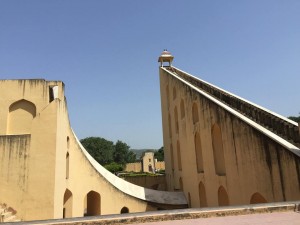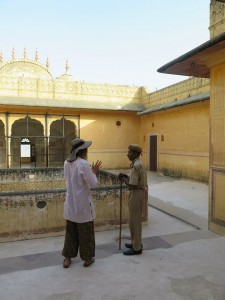Namaste! Hello!

Largest sundial in the world, tells the time in Jaipur with within an accuracy range of 2 seconds. This structure is over 200 years old and was the central structure for society when it was built – this society was entirely dependent on horoscope and celestial rhythm for everything from deciding to plant certain crops during a season, to the compatibility of individuals’ marriage, to a persons’ occupation, or even what a person should eat each day. There are many other stone structures that were built to decipher the stories of the stars and planet motions, all of which are astoundingly intricate.

This is a 500 year old fort, part of an extensive defense system including a great wall, built on a mountain ridge to protect Jaipur from the invading Mogals. I am asking the guard what the significance of the number 5 is (as you can see in 5 pillar structures that point into the sky) that was obviously an important architectural feature. Unfortunately the language barrier made it challenging to convey this question.
I am a junior at Whitman College, and this semester I have the enormous privilege to study abroad in India! For the next three months, I will be immersed in a splendor of sounds, sights, tastes, textures, weather, words, and eyes that I am previously unfamiliar with. My purpose in pursuing this experience is to evolve as a “global citizen”; to become a better human by gaining insight on humanity. I am living with the infamous Bhatt family of Jaipur. The Bhatts are a large family renowned through generations for Indian classical music! Last winter, I began studying sitar at Whitman and was eager to continue my practice while in India. By some miraculous stroke of luck, I have landed under the Bhatt roof and am practicing sitar daily! If you are unfamiliar with sitar or classical Indian music, I encourage you to listen look into the instrument. It is unique and captivating.
The Bhatt family house is situated in central-south Jaipur, on a quiet road down the block from an ashram (where I have begun to practice yog/yoga in the morning) and conveniently close to a market. My room is has bright blue walls and three windows, and connects to the sitar practice hall through ornate stain glass doors, so when students are playing I am serenaded by raga and melody.
I have been in Jaipur for about one week and the weather has been consistently sweltering. There have been two monsoon rains, which brought powerful winds, whipping any loose objects into the air and all around. I have come at the end of the typical monsoon season, but apparently this season was unusually light so there are expected to be more rains. This means the air will remain hot and sticky for a while longer. It has been interesting to notice my body and emotions adjusting to the disappointed expectation of autumn. For the past 20 years, I have experienced the transition of summer into fall, and I am my recognizing this habitual rhythm of emotions, stress (more accurately lack of stress). I do miss the slow coming of crisp evenings and vigorous colors.
I have seen and experienced many aspects of Jaipur in the past week, all of which I have found enlightening, but I would like most to share the general ways in which I am processing the things I am experiencing. The cultures of the peoples I have come to meet are vibrant with hues and textures I have never known directly. For example, kinship and family relations are the crux of daily life. The individualism and independence that shapes my behaviors are not reflected in the culture at large, or the people that constitute the culture. Everything a person does is held in the consciousness of others – whether on the street or in your own home, there are always people watching and connecting to your activities. Growing up without the appeal to privacy would shape one to find comfort in the presence of others, maybe even leading to a sense of identity that depends on the energy of others. This mindset is seen when standing in line for a train ticket – people will stand body to body, in the US we’d say they’re literally ‘on top’ of you, even if there is space around them. People are just comfortable with close proximity and physical contact, whereas in the US it is considered rude or awkward to threaten one’s personal space.
The sheer population of India, especially in urban areas lends to this, as there are no sprawling backyards, and houses are not thousands of square feet. Everything is closer, more intimate. People literally share the breathe of one another. Traffic in Jaipur reflects this point perfectly.
At first listen, a westerner may perceive the people of urban India to be either insane, angry, or simply unpleasant. The honking that is produced from a single car horn within 1 minute on a street in Jaipur is comparable to the honking produced over 6 months from my car in the US. Drivers honk at every intersection, they honk driving down the road, they honk when they’re parking, they honk as they’re pulling out of a space, they honk as they’re pulling into traffic. Honk honk beep buhh beep waaaaa!! This is the mystical experience of India’s traffic from the sidewalk – once you’ve ridden in an auto rickshaw (a small vehicle without doors that I take to and from school or to other destinations), you come to understand the compassion of the Indian honk, the previously mysterious nature of the cacophony is revealed.
“Hello motorcycle, I’m right here!!” “Hey guys, I’m coming into this flow of traffic!” “Hey, welcome to this flow of traffic!!”
Drivers find lanes useless and vehicles seamlessly maneuver past around and through one another with ease and mastery, relying on continued communication of horns. Its quite elegant, the choreography of traffic. As if each car is an extended open palm to the anothers, motorcyclists know by the sound of the horn that the car behind them is aware of them, and there is, what us westerners would consider, immense trust shared between all.
There is also earnest care for life. There is no competition of speed, no trying to get others to rush. Each vehicle is doing what it is, and all others note, respect, and nurture the continuation of that vehicle’s trajectory.
There is much further to dive into by simply stepping outside my door, and this is true in all places! I forget that while I find the colors and fresh energy of this place engrossing, my home culture can be read in much the same way by simply stepping outside my door. Every moment is an opportunity to dive into the humanness of culture and perspective.
Thanks for reading this post, in the coming weeks I will post more details on the nature of the program and day-to-day life here in lovely Jaipur India, capital of the beloved central-north-west state, Rajasthan. Take care!

